Controlling stormwater drainage around your home is an important step in protecting the foundation’s integrity, as well as the the water quality of your in-ground pool, or the life and safety of your outdoor living space. It can be a hassle dealing with wet basements, pooling water on the patio, a flooding garage, or heavy sediment flowing into the pool. With proper planning and design, these events can be minimized or eliminated.
Two Part Problem
Home drainage should be addressed as a whole whenever there is new construction. However, this is not always possible, especially if you have purchased a pre-owned home and inherited a set of conditions. The necessity for stormwater management becomes more apparent when considering a patio or outdoor living space project.
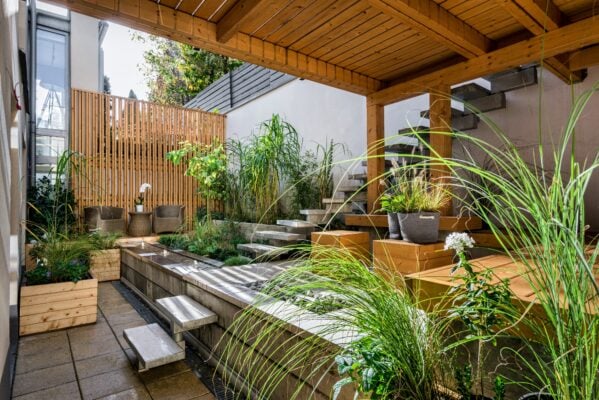
There are two characteristics that a pool deck, patio or outdoor living space have in common:
- A house or roofed structure is attached to them.
- They commonly have a surface that is impermeable to water (i.e. concrete or paver deck).
When considering the drainage of a given property, it is helpful to look at these two components independently and make design recommendations and decisions accordingly. This is not to say that their drainage plans can’t run together. If building from scratch, have the architect design a whole home drainage plan that is expandable. However, quite often a pool or living space is constructed after the home is built. If the initial home drainage is ill suited, the outdoor addition will complicate matters.
Stormwater Runoff Measurements
The U.S. Department of Commerce has put together maps of rainfall measurements (average over several years) that anyone can access. Likewise, the U.S. Geological Survey has some data on rainfall and flooding. Below is a general map of 100 year rainfall events for the 48 States. This data is in inches of rainfall per hour, and is an excellent tool for designing a drainage plan for your home or outdoor living structure.
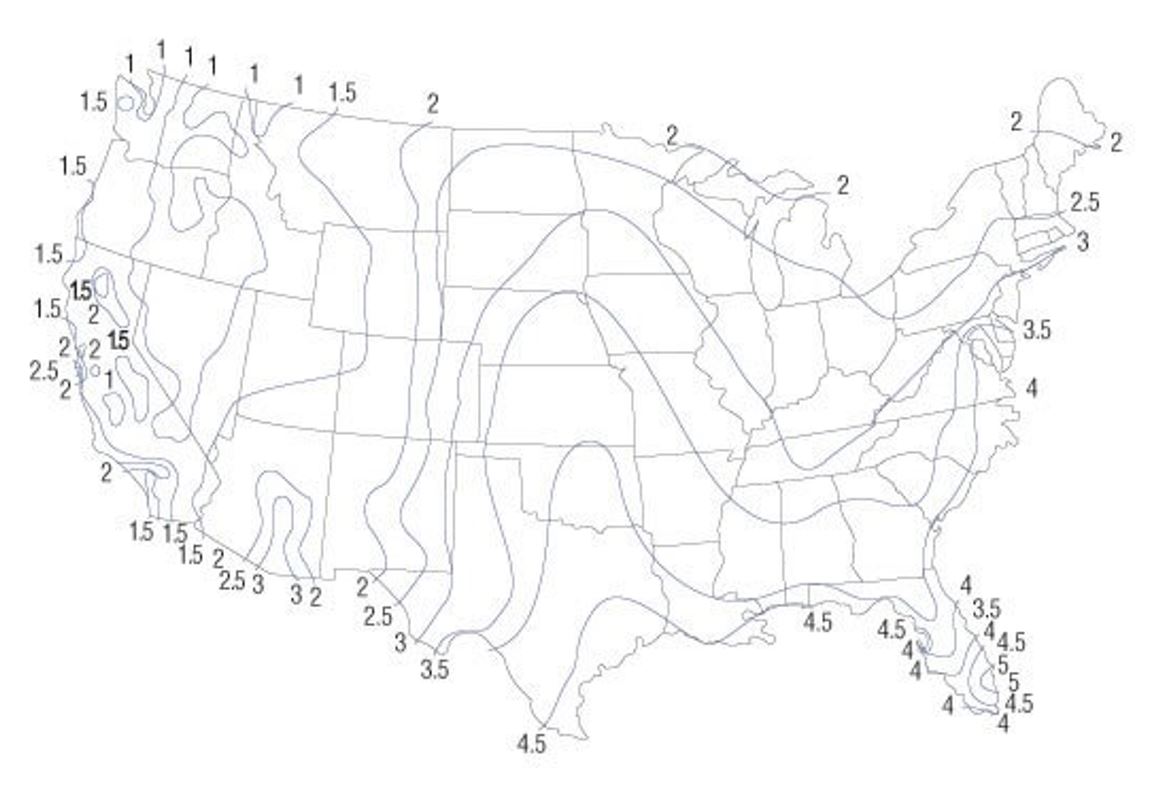
US Geological Survey of Rainfall per Hour Over 100 Years
How Much Is it?
An easy way to calculate the storm water runoff of your house or patio (in gallons per minute :GPM) is by using the modified Rational Method equation.
Q = (C x I x A) / 96.23
Q = Storm Water Runoff (in gallons per minute, gpm)
C = Coefficient of Runoff
I = Rainfall Intensity (in inches per hour)
A = Area of Drainage Zone (in square feet)
The Coefficient of Runoff, “C”, is a measure of how much water runoff your hardscape or yard will have. Your roof, patio, or concrete driveway will most likely have 100% (coefficient 1) of the rainwater runoff the surface and which requires redirecting to a designated drain area. A more permeable surface, such as sand or gravel, will have 60% runoff (coefficient 0.6) as water penetrates the ground and reduces total water flow. For hardscapes, we will use C=1.
Example: Dallas Driveway
For an individual that lives in Dallas, Texas (I = 4) and has a 25 foot wide x 100 foot long (A=2500) concrete (C = 1) driveway that gentle slopes toward the garage, the 100 year storm water run off would be calculated as follows:
Q = (C x I x A) / 96.23
Q = (1 x 4 x 2500) /96.23
Q = (10,000) / 96.23
Q = 103.91 gallons per minute (running toward your garage door) in a 100 year rainfall event.
When we look at a 25 year rainfall event, that volume of runoff water drops to about 65 gallons per minute. So, when designing a trench drain system for in front of your garage, you’ll need one that can remove 65 to 104 gallons of water each minute. Moreover, you’ll also need a drainage outlet pipe that can handle that volume, which would be minimum of 6” smooth walled pipe.
Looking for an easier way to calculate water runoff? NDS® is one of many drain manufactures which cater to the residential market. They have easy to use calculators that help determine drainage runoff from of a given area and the pipe size needed for evacuating that water away.
Managing Roof Drainage
We just did a little drainage exercise for a 2500 square foot driveway. That Dallas Texas storm event of 2.5 inches per hour generated around 65 gallons per minute. If that is the square footage of your roof, you’ll be looking at the same volume of water. Except now, (assuming there are gutters on your home) you will be able to divide the runoff into roughly 6 to 8 downspout locations. The runoff per downspout would average around 8 – 10 gallons per minute
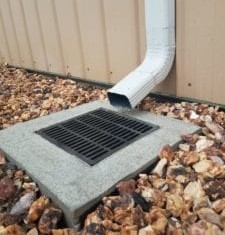
I believe it is important to isolate and address your roof drainage prior to considering your patio drainage issues. Many times, patio drainage issues are due to not dealing with roof drainage first. Below are a few best practices to follow that will help keep your home foundation intact and basement dry.
Have a French Drain (not Trench Drain) at the base of your home’s foundation footer. This keeps ground water pressure away from the basement walls and floor, helping to avoid water damage and deterioration. A French drain often uses a mesh wrapped perforated corrugated pipe to direct water. A sump pump can be used in conjunction with the French drain in particularly soggy settings.
It is always a good idea to keep large trees, shrubs and their roots away from the house and it’s structures. That small maple tree you planted in the front yard when the house was just built can start to do evil things to your foundation after 25 years, especially block type foundations. Keeping trees at a distance can help deter underground property damage and keep gutters clean of debris.
Directing your gutter drain away from the home’s foundation is a great way to help deter area flooding and damage to the property. Have each downspout terminate into a catch basin. Consider a series of collection points connected by underground piping that can be guided. Transfer this water to a natural drainage spot, a storm sewer or even to an underground collection point. A Flo-Well™ for example, is an excellent product for removing large amounts of water in this fashion. Used independently or as part of a larger system, Flo-Well™ units collect and detain up to 50 gallons of storm water allowing the ground water to dissipate.
Let’s not forget your driveway. It came with your house. Hopefully, your house sits elevated above the street level, so your driveway doesn’t drain toward the house. If you are constantly fighting water infiltration into your garage, you will need to consider a trench drain across the garage door to help move that water away from your foundation. As an option, you can direct this water to the same drainage system that your downspouts are using. Make sure you have cleanouts in your plumbing so the occasional clog can be dealt with. When discussing a drainage project, an excellent source of information can be provided by landscape or excavating contractors.
Once you’ve studied and managed your house run-off water, you’ll probably have a better idea on how to handle a pool, patio or outdoor living space addition.

Managing Outdoor Living Space Drainage
Patios, pools and outdoor living spaces can be a significant investment and usually the second most expensive addition to your home. Getting these areas to drain correctly is important on many levels.
By installing trench drain along a wall, at the bottom of a step, or around a pool it helps to protect your investment. Improper drainage on your deck or patio can lead to.
- Pooling water which causes safety issues, discoloration, and damage
- Water leaking under the deck can cause deck washouts and frost heaving
- Storm water runoff entering the pool and changing the pH and alkalinity, leading to increased maintenance.
And let’s not forget the cost and headache of having to deal with problems which could have been prevented with some preemptive planning. You should be enjoying this outdoor space, not regretting it. So, if you are planning to invest in backyard living, consider speaking with a landscape architect or qualified pool contractor to help in the process.
Drainage Management Strategies
It’s good to remember that maintenance of your drainage system is as important as the drainage itself. Though not to be the final word on drainage recommendations, here are a few strategies that have continued proven solutions over the years.
Design your deck to be a high point – Make sure your patio or living space is elevated above the surrounding yard and landscaping slopes away from the decking. If your patio or hardscape is small enough, slope the surface so that water runs off the deck naturally into the yard. Use a French drain at the perimeter of the patio/landscaping interface to help collect and drain water, if necessary.
Retaining walls and planters need space – Though beautiful and sometimes necessary, overflowing planters and retaining wall waterfalls can mean big problems for your pool and patio. Storm water can bring an assortment of organic matter into your living space to cause a real mess. If a planter or retaining wall is in your plan, place a swale or French drain between it and the patio. Have your in-patio flower garden well below the level of the deck and have an atrium style grating as part of your drainage plan for that area.
Elevate your pool edge – This is a common place detail that most pool builders will incorporate to guard against flows of unwanted stormwater and debris. By raising the pool edge water runoff is diverted to the surrounding landscape or into a trench drain system .
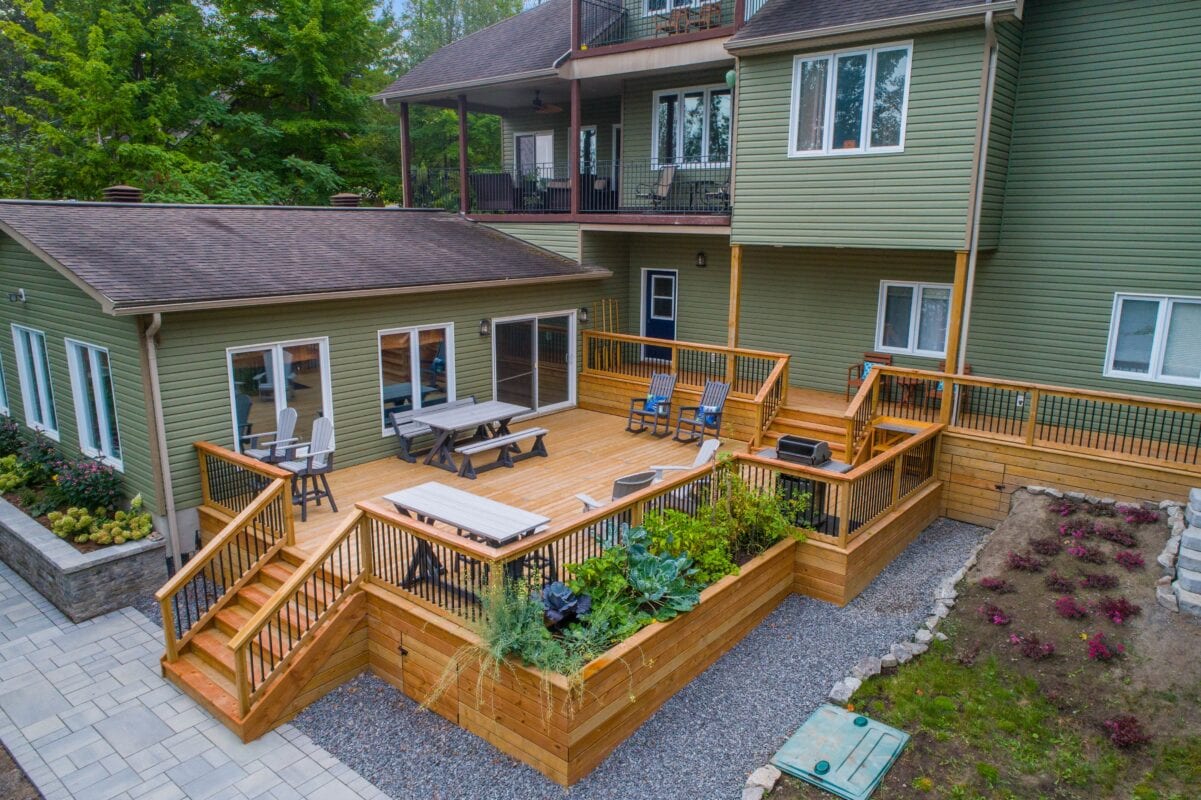
An elevated outdoor living space allows water to naturally run off into the yard and surrounding area.
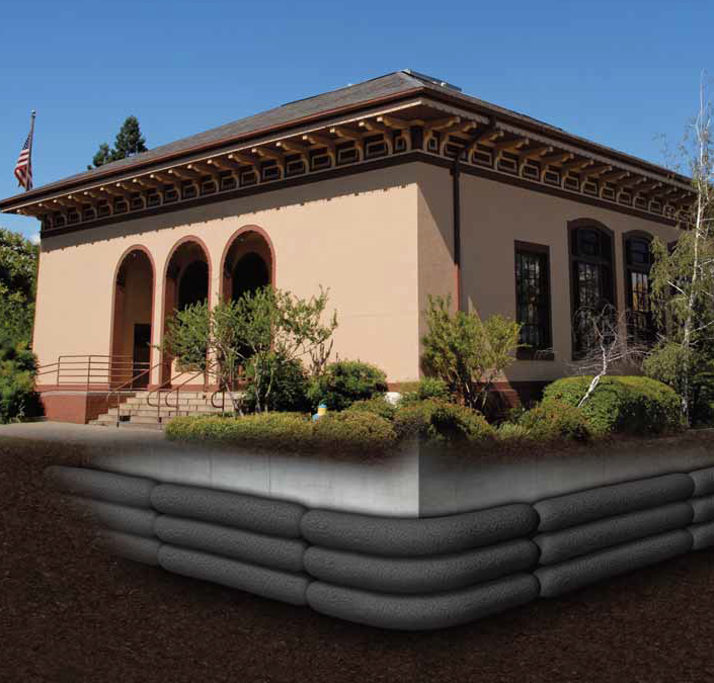
French drain at the foundation of a building or retaining wall helps to collect and drain water.
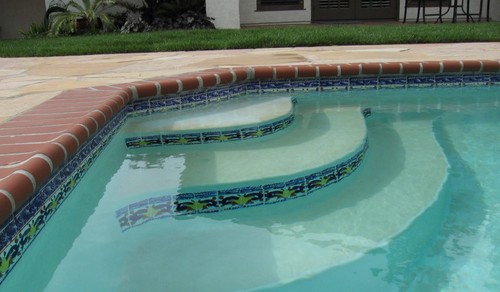
A raised pool edge helps to prevent storm water from draining into the pool instead of into the surrounding landscape or trench drain system.
Don’t Undersize Your Drain
If a deck drain is needed, it is recommended to use one wide enough to meet the needs of the water flow. Often times the smaller “1 inch wide” deck drains are undersized (depending on the application) and are not capable of handling the larger amounts of water flowing from the roof, patio, or pool areas.
By using the information provided in this article, you can determine the drainage area and the rainfall for your location, as well as calculate the size of drain you will need. It is a best practice to slightly increase the size of the drain you think you need. This is considered a preemptive step regarding area drainage and water flow rates for those unexpected torrential downpours.
Leaves and other debris can constrict the grating during these large downpours making your drain less efficient. A wider drain can help in the overall maintenance of the hardscape and can become a conversation piece at the same time with decorative grating.
After reading this article, you may still have questions about finding the best drainage solution for your project. Trench Drain Systems (TDS) has experts who can help find the right drains to fit into your plan and budget. Contact us to request a quote by calling 610-638-1221 or email [email protected]. For further information on drainage visit www.TrenchDrain.com or www.DrainageKits.com.

